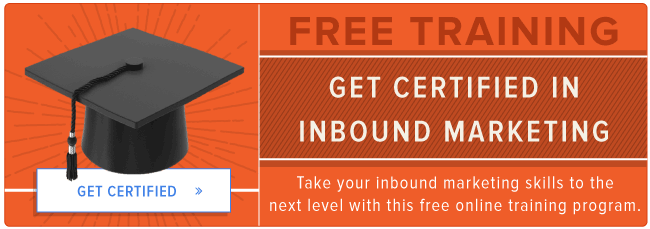When you're first starting to learn something new, it's easy to feel overwhelmed and intimidated.

Why? Maybe it's been a while since you've deviated from the things you're good at and know well. Or maybe you had to make a pretty significant monetary or time investment, and you're feeling the pressure. Perhaps you have all the drive in the world to learn ... but you're having trouble finding the right resources and references to learn from.
A lot of people learning inbound marketing for the first time run into concerns like these -- and we want to help them out. Whether you're totally new to inbound marketing or just want to sharpen your existing inbound chops, here are 10 totally free ways to teach yourself inbound marketing skills.
10 Free Ways to Teach Yourself Inbound
1) Subscribe to top inbound marketing blogs.
This is usually the first tip marketers will recommend for learning inbound: Subscribe to a bunch of awesome blogs, and then spend time every day reading them.
The problem? There are so many to awesome ones choose from. With only so much time in the day to devote to reading, you need to subscribe strategically.
We'd recommend checking out Inbound50 to help you make your choices. This resource will give you a great list of quality blogs to follow. And if you already know you'd like to subscribe to HubSpot's blogs (thanks!), you can click this link.
2) Subscribe to emails from other companies.
Reading about how to do inbound is a crucial part of learning inbound, but it's not the only thing you should do. You should also be on the lookout for examples of awesome (and not so awesome) inbound marketing. This'll give you real-world references for the theories and tips you're reading on inbound marketing blogs.
The best way to do that? Hand over your email address to other companies to see firsthand how they market to customers and prospects. Subscribe to their blog. Give over your email in exchange for an ebook. Click on the emails they send you so you keep getting more.
All the while, take note of what you like and what you don't like -- and save the most memorable examples to reference later. Having real, tangible examples of marketing will help you better apply inbound concepts in the future.
3) Get your Inbound Certification.
Like to have a little more direction when learning inbound? HubSpot's Inbound Certification could be right up your alley.
Block off a few hours to take this 11-course series. You'll watch a series of videos about the whole methodology and at the end, take an exam. If you pass, you'll receive a badge and certificate you can add to your website, resume, LinkedIn profile, and Inbound.org profile. That way, current and future employers will know that you've got inbound skills down pat.
4) Run Marketing Grader reports for your favorite websites -- and then create a plan to improve their score.
To get a peek under the hood of how your favorite companies do marketing, run a Marketing Grader report on them. The report will take a look at a company's website, social media accounts, blog, and mobile strategy, and it'll give 'em a grade along with recommendations on how to improve their score. Running this report will help you better dissect what the company is doing that is working ... and isn't working.
Then, pretend you work for the company and have to fix their Marketing Grader score. What would you do? Create mock-ups, new copy, and anything else you think would improve the score. This will help you get more inbound marketing practice. (And if you're looking for a new gig at the company you're grading, it could help you get your foot in the door.)
5) Replicate the work of people and companies you admire (for practice only).
My coworker Sapphire suggested this in a post on learning design, but the tip can apply to inbound as a whole.
Once you have some examples of marketing from companies you admire, sit down and see if you can replicate their work. Can you design an email with a similar layout? Write a blog post on a similar topic? Create similar images and copy for Twitter?
Forcing yourself to recreate a specific piece of successful marketing makes it much easier for you to pick up new skills. You're focused on learning something specific, not all the things in marketing.
Be super careful not to publish anything that's an exact copy of someone's work, though. You should be using other companies to guide your learning process, not rip off their marketing for your company's benefit.
6) Let Inbound.org critique your work.
Ever poked around Inbound.org? It's an awesome community of inbound marketers and a place where you can find lots of helpful content and connect with others in the industry.
One of the coolest features of the website is the ability to ask for feedback. Submit a link and an image of a piece of marketing you'd like critiqued (landing pages, emails, blog posts, social posts, and so on), and the community will give you tips on what you can improve. They can even mark up the image you submit to give you smaller, very specific points of feedback. We used this feature recently to get feedback on one of our landing pages, and got some incredibly insightful pointers.
As you're developing your inbound skills, think about asking for feedback on your work. No matter whether you're just starting out or been doing inbound for years, it's important to solicit feedback from smart, helpful folks -- and then use it to work on improving your skills.
7) Enroll in self-learning courses.
If you prefer to have others actually walk you through new concepts, you could try taking a free online class. Some of our favorites include:
- Codecademy: This site is great if you're looking to develop some coding or techincal skills.
- Lynda: Recently acquired by LinkedIn, Lynda offers tons of free courses on design, web development, photography, business, etc.
- Coursera: This platform will help you find Massive Open Online Courses (MOOCs) -- free online courses from top universities on tons of different topics.
8) Work off templates.
Especially when you're first starting out in a new part of marketing, having a template to work off of is incredibly helpful. Why? They make your world just a little smaller, making it easier for you to produce something.
Let's say you're writing a blog post, for example. Normally, you need to worry about the structure, writing, formatting, images, and optimization before you hit publish. With a template, the structure is taken care of already, allowing you to focus on nailing the rest of the things you need to do.
There are tons of free templates you can find online -- and we've got a bunch you can check out, too. Click here to see what templates we have.
9) Bookmark glossaries and helpful resources.
As you're reading and learning about inbound, you're going to come across some amazing resources you don't want to live without. Don't let them fall by the wayside! Make sure to bookmark them in your browser so you can easily refer to them later.
One thing I especially love to bookmark are glossaries, like our smarketing glossary. There are so many terms you'll come across in marketing, so having easy-to-access definitions comes in handy more often than you'd think.
10) Read case studies.
Want to know how companies have fixed their marketing problems? Check out case studies. They typically document the problems companies have run into, specific changes they made to fix those problems, and the study's results, making them great learning resources for newbie and experienced marketers alike.
Many case studies can be found on marketing agency or software websites. Even though they're ultimately supposed to help sell readers on the value of the company, they're often quite informative and helpful learning resources.
But if you want some that aren't tied to something someone's selling, I'd recommend checking out MarketingSherpa -- they've got some great free marketing case studies.
The moral of the story here? Learning inbound isn't necessarily quick, but there are tons of free, helpful resources out there that'll suit any learning style.
What other tips do you have for learning inbound?


![The Fundamentals of Inbound Marketing [Free Training Deck]](https://blog.hubspot.com/hs-fs/hub/53/file-1102562866-gif/inbound-marketing-overview-training-presentation-1-1.gif)
